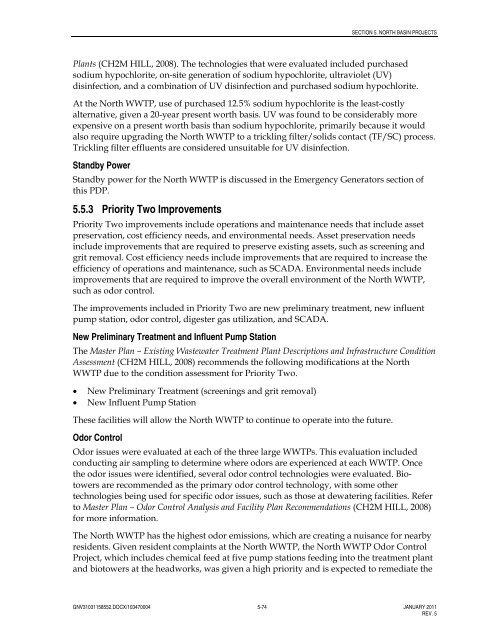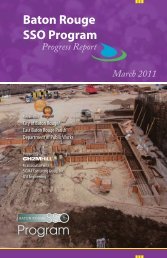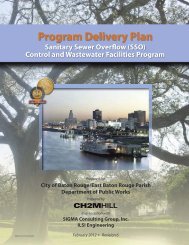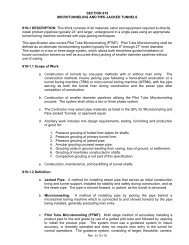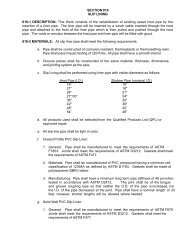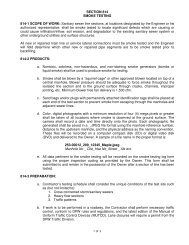Program Delivery Plan
Program Delivery Plan - Baton Rouge Department of Public Works ...
Program Delivery Plan - Baton Rouge Department of Public Works ...
- No tags were found...
Create successful ePaper yourself
Turn your PDF publications into a flip-book with our unique Google optimized e-Paper software.
SECTION 5. NORTH BASIN PROJECTS<br />
<strong>Plan</strong>ts (CH2M HILL, 2008). The technologies that were evaluated included purchased<br />
sodium hypochlorite, on-site generation of sodium hypochlorite, ultraviolet (UV)<br />
disinfection, and a combination of UV disinfection and purchased sodium hypochlorite.<br />
At the North WWTP, use of purchased 12.5% sodium hypochlorite is the least-costly<br />
alternative, given a 20-year present worth basis. UV was found to be considerably more<br />
expensive on a present worth basis than sodium hypochlorite, primarily because it would<br />
also require upgrading the North WWTP to a trickling filter/solids contact (TF/SC) process.<br />
Trickling filter effluents are considered unsuitable for UV disinfection.<br />
Standby Power<br />
Standby power for the North WWTP is discussed in the Emergency Generators section of<br />
this PDP.<br />
5.5.3 Priority Two Improvements<br />
Priority Two improvements include operations and maintenance needs that include asset<br />
preservation, cost efficiency needs, and environmental needs. Asset preservation needs<br />
include improvements that are required to preserve existing assets, such as screening and<br />
grit removal. Cost efficiency needs include improvements that are required to increase the<br />
efficiency of operations and maintenance, such as SCADA. Environmental needs include<br />
improvements that are required to improve the overall environment of the North WWTP,<br />
such as odor control.<br />
The improvements included in Priority Two are new preliminary treatment, new influent<br />
pump station, odor control, digester gas utilization, and SCADA.<br />
New Preliminary Treatment and Influent Pump Station<br />
The Master <strong>Plan</strong> – Existing Wastewater Treatment <strong>Plan</strong>t Descriptions and Infrastructure Condition<br />
Assessment (CH2M HILL, 2008) recommends the following modifications at the North<br />
WWTP due to the condition assessment for Priority Two.<br />
<br />
<br />
New Preliminary Treatment (screenings and grit removal)<br />
New Influent Pump Station<br />
These facilities will allow the North WWTP to continue to operate into the future.<br />
Odor Control<br />
Odor issues were evaluated at each of the three large WWTPs. This evaluation included<br />
conducting air sampling to determine where odors are experienced at each WWTP. Once<br />
the odor issues were identified, several odor control technologies were evaluated. Biotowers<br />
are recommended as the primary odor control technology, with some other<br />
technologies being used for specific odor issues, such as those at dewatering facilities. Refer<br />
to Master <strong>Plan</strong> – Odor Control Analysis and Facility <strong>Plan</strong> Recommendations (CH2M HILL, 2008)<br />
for more information.<br />
The North WWTP has the highest odor emissions, which are creating a nuisance for nearby<br />
residents. Given resident complaints at the North WWTP, the North WWTP Odor Control<br />
Project, which includes chemical feed at five pump stations feeding into the treatment plant<br />
and biotowers at the headworks, was given a high priority and is expected to remediate the<br />
GNV31031158552.DOCX/103470004 5-74 JANUARY 2011<br />
REV. 5


